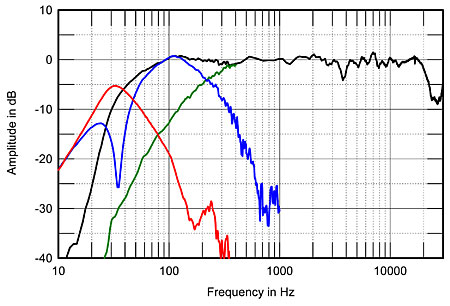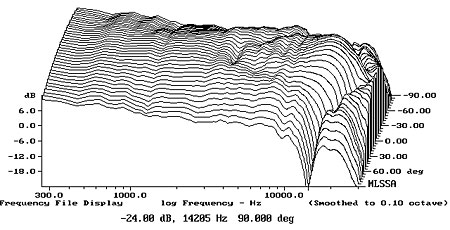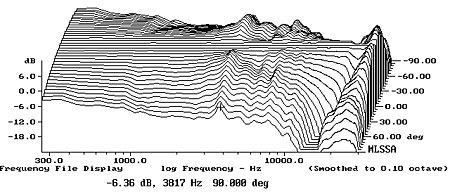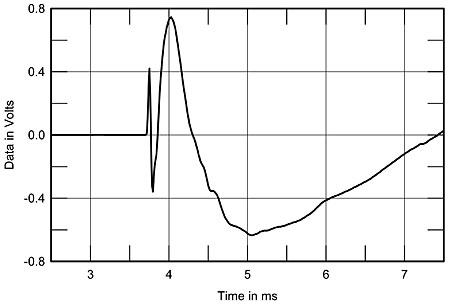| Columns Retired Columns & Blogs |
Sonics by Joachim Gerhard Allegra loudspeaker Measurements
Sidebar 3: Measurements
The Sonics Allegra's voltage sensitivity is specified as a high 91dB/W/m. Assessed with DRA Labs' MLSSA system, my B-weighted estimate on its tweeter axis was close to that, at 90.2dB(B)/2.83V/m. However, the Allegra is a fairly difficult speaker for the partnering amplifier to drive, with an impedance magnitude (fig.1, solid trace) lying at or below 4 ohms in the bass and the low treble. The electrical phase angle (fig.1, dotted trace) is also relatively large over much of the audioband. The minimum impedance is 2.75 ohms at 3.2kHz, though the phase angle is low at that frequency. More taxing to the amplifier will be the combination of 4.7 ohms and –42° at 24Hz, but fortunately, there is rarely significant musical energy present in the very low bass.

Fig.1 Sonics Allegra, electrical impedance (solid) and phase (dashed). (2 ohms/vertical div.)
Other than a slight blip at 36kHz, the primary resonant frequency of the small-diameter metal-dome tweeter, the traces in fig.1 are free from the discontinuities that would imply the existence of enclosure panel resonances of various kinds. Nevertheless, when I investigated the vibrational behavior of the cabinet surfaces with a plastic-tape accelerometer, I did find some resonant modes on the head unit's top and side panels (fig.2). Fortunately, these are fairly low in level and the affected areas are small, which will significantly reduce their audibility. The bass bin's sidewalls were also a little lively (not shown), but individual modes were relatively low in level.

Fig.2 Sonics Allegra, cumulative spectral-decay plot calculated from output of an accelerometer fastened to center of head-unit side panel (MLS driving voltage to speaker, 7.55V; measurement bandwidth, 2kHz).
I found no significant difference in frequency response between the two woofers; the sum of their individual responses, measured in the nearfield, is shown in fig.3 (blue trace). The crossover to the midrange unit (green) occurs at around 230Hz, and the woofers roll off smoothly with a slope slightly greater than a 12dB/octave, second-order. The midrange unit also rolls off with a second-order slope. The reflex loading of the woofers gives rise to a well-defined minimum-motion notch at 33Hz, the tuning frequency of the rear-facing port. The port itself (fig.3, red) peaks slightly lower in frequency than the notch in the woofer's output, but rolls off smoothly above its passband. While slight peaks are evident around 250 and 330Hz in the port's output, these are well down in level. The Allegra's overall bass response doesn't show the usual "2pi" boost, so the tuning of the woofers would appear to be a little on the overdamped side. Given the usual in-room boost that results from the proximity of room boundaries, this will give clean, extended, well-defined low-frequency behavior.

Fig.3 Sonics Allegra, anechoic response on tweeter axis at 50" without grille (black), averaged across 30° horizontal window and corrected for microphone response, with the nearfield responses of the midrange unit (green), woofers (blue), and port (red), plotted in the ratios of the square roots of their radiating areas below 400Hz, 1kHz, and 350Hz, respectively, and the complex sum of their nearfield responses plotted below 300Hz (black).
Higher in frequency in fig.3, the Allegra offers an extraordinarily flat response on the tweeter axis, with only a slight notch evident at the bottom of the tweeter's passband. But as shown by the plots of the speaker's lateral dispersion (figs. 4 and 5), this notch fills in to the speaker's sides, resulting in a smooth, even launch of sound into the room. The use of a small-diameter tweeter results in better-than-usual dispersion above 8kHz, but the output at extreme off-axis angles is still well down by 16kHz. In the vertical plane (fig.6), the Allegra maintains its output over quite a wide window, other than the notch at 3.3kHz deepening well above and below the tweeter axis (which is 37.5" from the floor).

Fig.4 Sonics Allegra, lateral response family at 50", from back to front: responses 90–5° off axis, response on tweeter axis, responses 5–90° off axis.

Fig.5 Sonics Allegra, lateral response family at 50", normalized to response on tweeter axis, from back to front: differences in response 90–5° off axis, reference response, differences in response 5–90° off axis.

Fig.6 Sonics Allegra, vertical response family at 50", normalized to response on tweeter axis, from back to front: differences in response 15–5° above axis, reference response, differences in response 5–15° below axis.
Turning to the time domain, the Allegra's step response on the tweeter axis (fig.7) indicates that the tweeter and midrange unit are connected with positive acoustic polarity and the woofers with inverted polarity, this confirmed by looking at the step responses of the individual units (not shown). You can see in fig.7 that the overshoot of the tweeter's step (the small positive-going spike at the 3.7ms mark) smoothly blends into the slower-rising step of the midrange unit (the spike at 4ms), which in turn blends into the even-slower-rising, inverted step of the woofers (at 4.3ms). This blending correlates with the excellent integration of the drive-unit outputs in the frequency domain and demonstrates, with respect to the midrange/woofer crossover, that with second-order crossover filters, you need to connect the units in opposite polarity to achieve the optimal blend.

Fig.7 Sonics Allegra, step response on tweeter axis at 50" (5ms time window, 30kHz bandwidth).
Finally, the Allegra's cumulative spectral-decay plot on the tweeter axis (fig.8) is very clean in the region covered by the woofer, though some low-level hash is evident at the top of the midrange unit's passband.

Fig.8 Sonics Allegra, cumulative spectral-decay plot on tweeter axis at 50" (0.15ms risetime).
There is much to admire in the Sonics by Joachim Gerhard Allegra's measured performance, and nothing to indicate why Brian Damkroger had to work so hard to optimize its performance in his listening room.—John Atkinson
- Log in or register to post comments




































